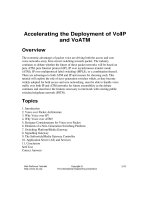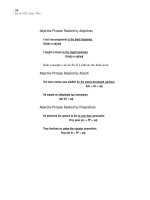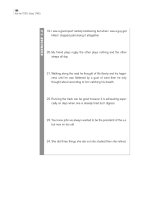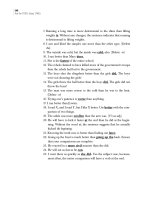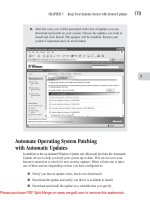Tài liệu PHP: The Good Parts: Delivering the Best of PHP- P5 ppt
Bạn đang xem bản rút gọn của tài liệu. Xem và tải ngay bản đầy đủ của tài liệu tại đây (309.91 KB, 20 trang )
if ($height) $this->tag .= 'height="' . $height . '" ' ;
$this->tag .= ">" ;
return $this->tag ;
}
function ColumnOn($colspan=1, $align='left', $width="", $rowspan="",
$bgcolor="", $class="", $valign="", $height="") {
$this->tag = '<td ' ;
if ($align) $this->tag .= 'align="' . $align . '" ' ;
if ($colspan) $this->tag .= 'colspan="' . $colspan . '" ' ;
if ($width) $this->tag .= 'width="' . $width . '" ' ;
if ($rowspan) $this->tag .= 'rowspan="' . $rowspan . '" ' ;
if ($bgcolor) $this->tag .= 'bgcolor="' . $bgcolor . '" ' ;
if ($class) $this->tag .= 'class="' . $class . '" ' ;
if ($height) $this->tag .= 'height"' . $height . '" ';
if ($valign) $this->tag .= "valign='" . $valign . "'>" ;
if (!$valign) $this->tag .= "valign='middle'>" ;
return $this->tag ;
}
function ColumnOff() {
$this->tag = '</td>' ;
return $this->tag ;
}
function RowOff() {
$this->tag = '</tr>' ;
return $this->tag ;
}
function End() {
$this->tag = '</table>' ;
return $this->tag ;
}
} // end class table
Here is the code to build the form class:
class form {
private $tag ;
function Begin($action, $method='post', $name='', $id='', $style='', $class='') {
$this->tag = '<form ' ;
if ($method) $this->tag .= 'method="' . $method . '" ' ;
if ($action) $this->tag .= 'action="' . $action . '" ' ;
if ($name) $this->tag .= 'name="' . $name . '" ' ;
if ($id) $this->tag .= 'id="' . $id . '" ' ;
if ($style) $this->tag .= 'style="' . $style . '" ' ;
if ($class) $this->tag .= 'class="' . $class . '" ' ;
$this->tag .= "><input type='hidden' name='posted' value='1'>" ;
return $this->tag ;
}
function HiddenValue($name, $value="") {
$this->tag = '<input type="' . 'hidden' . '" ' ;
Putting It into Practice | 63
Please purchase PDF Split-Merge on www.verypdf.com to remove this watermark.
if ($name) $this->tag .= 'name="' . $name . '" ' ;
if ($value) $this->tag .= 'value="' . $value . '" ' ;
$this->tag .= ">" ;
return $this->tag ;
}
function InputLabel($textLabel, $labelFor, $required=false, $class='') {
if ($required == true) $required = "<font color='red'>*</font>";
$this->tag = '<label for="' . $labelFor . '" class="' . $class . '">' ;
$this->tag .= $textLabel . $required;
$this->tag .= ": </label>" ;
return $this->tag ;
}
function Input($InputType, $EntityName, $value="", $align="center", $size="",
$id="", $align="center", $readonly="", $class="",
$onType1="", $onAction1="", $onType2="", $onAction2="",
$onType3="", $onAction3="") {
$this->tag = '<input type="' . $InputType . '" name="' . $EntityName
. '" size="' . $size . '" ' ;
if ($align) $this->tag .= 'align="' . $align . '" ' ;
if ($id) $this->tag .= 'id="' . $id . '" ' ;
if ($value == "on"){
$this->tag .= ' checked ';
} elseif ($value){
$this->tag .= 'value="' . $value . '" ' ;
}
if ($class) $this->tag .= 'class="' . $class . '" ' ;
if ($onType1) $this->tag .= $onType1 . '="' . $onAction1 . '" ' ;
if ($onType2) $this->tag .= $onType2 . '="' . $onAction2 . '" ' ;
if ($onType3) $this->tag .= $onType3 . '="' . $onAction3 . '" ' ;
if ($readonly) $this->tag .= 'readonly ' ;
$this->tag .= ">" ;
return $this->tag ;
}
function Textarea($name, $cols, $rows, $value="", $align="left", $class="",
$readonly="", $onType1="", $onAction1="", $onType2="", $onAction2="",
$onType3="", $onAction3="") {
$this->tag = '<textarea name="' . $name . '" cols="'
. $cols . '" rows="' . $rows . '" ' ;
if ($align) $this->tag .= 'align="' . $align . '" ' ;
if ($class) $this->tag .= 'class="' . $class . '" ' ;
if ($onType1) $this->tag .= $onType1 . '="' . $onAction1 . '" ' ;
if ($onType2) $this->tag .= $onType2 . '="' . $onAction2 . '" ' ;
if ($onType3) $this->tag .= $onType3 . '="' . $onAction3 . '" ' ;
if ($readonly) $this->tag .= 'readonly ' ;
$this->tag .= ">$value</textarea>" ;
return $this->tag ;
}
function form_end(){
return '</form>' ;
64 | Chapter 6: Objects
Please purchase PDF Split-Merge on www.verypdf.com to remove this watermark.
}
} // end class form
It
makes great sense to save these files as separate includable files; I would save them
as html_class.inc, table_class.inc, and form_class.inc, respectively, and then include
them—or better still, require them—into the code file where they will be used. These
three files are just the object definitions (the classes) and it does look like a lot of code
for little gain (or, as they say in my part of the world, trying to drive in a thumbtack
with a sledgehammer).
In PHP, if you want to create (instantiate) an active class (an object) use the new key-
word. Here is an example of the top part of a file that is using and instantiating all three
classes:
// require classes for the page
require_once ('classes/html_class.inc');
require_once ('classes/table_class.inc');
require_once ('classes/form_class.inc');
// instantiate classes (prepare them for use)
$HTMLPage = new html("GuestBook Page") ;
$MyTable = new table() ;
$MyForm = new form() ;
Next, we want to start using the methods within these classes to build a web page that
will accept a first name with a display of 30 characters, a last name with a display of 40
characters, and a comment area of 8 rows and 40 columns. Again, we will keep it simple
in design and process, just to get the points of OPP across. Hopefully, you will be able
to extrapolate this context into a fully operational OOP library.
So let’s get back to the design of the web page form. Figure 6-1 shows the simple form
for which we will be writing the code below.
Magic Methods
You may notice that in the HTML class definition there is a function called
__construct. This is a special method that you can define for each class that is triggered
(executed) each time the class is instantiated. What we are doing here is establishing
the basic top of an HTML page at the same time that we are creating the object in
memory. Additionally, we are passing in a value that will be used for the page title. This
__construct method is actually looked for and executed each time a class is instantiated,
whether or not the code for the method is actually written. If the method is not written,
it will be called, but nothing will happen visibly.
The automatic method we use here (__construct) is part of a collection of predefined
methods known as magic methods. These magic methods are all inherently defined
within each class that you build within PHP. Even if you don’t write the code for them
yourself, they still exist and the PHP parser will use them or call them as needed,
Magic Methods | 65
Please purchase PDF Split-Merge on www.verypdf.com to remove this watermark.
although the definition will be that of the default behaviour PHP has assigned to it.
Another magic method that is quite often used is the destructor method (__destruct).
It is called when an object is removed from active use or when a script ends. If you want
something special to be performed as the object is being destroyed, create this method
within your class definition and add your desired code to it.
You may notice in the HTML class code that there is a __construct
method
echoing out the content of the top of a web page
(<HTML><HEAD>, etc.). This is merely an example of the use of one of the
magic methods. Also note that this method is not returning a value, as
magic methods are not permitted to do so.
Be sure to look up the other magic methods on the PHP website.
$this
In the class code above, you can see a variable called $this. $this is an internal and
reserved variable used within the defined objects. You don’t have to predefine it; it will
be there for your use as soon as a class in instantiated into an object. It is used for
internal references to properties, as can be seen in its referential use in relation to the
Figure 6-1. A simple form generated by object-oriented code
66 | Chapter 6: Objects
Please purchase PDF Split-Merge on www.verypdf.com to remove this watermark.
$this->tag variable. In fact, you have to use the $this-> prefix to make internal refer-
ence to a class property.
Objects in Action
Here is the code creating the remainder of the page. We will briefly dissect it following
the listing:
// start a table with a border, left alignment, and 30% width
$webpage = $MyTable->Begin(1, "left", "500") ;
$webpage .= $MyTable->RowOn();
$webpage .= $MyTable->ColumnOn();
$webpage .= $MyForm->Begin() ; // "proof" of polymorphism
$webpage .= $MyForm->InputLabel("FirstName","fname", true);
$webpage .= $MyTable->ColumnOff();
$webpage .= $MyTable->ColumnOn(1,"left");
$webpage .= $MyForm->Input("text", "fname", "", "", 30);
$webpage .= $MyTable->ColumnOff();
$webpage .= $MyTable->RowOff();
$webpage .= $MyTable->RowOn();
$webpage .= $MyTable->ColumnOn();
$webpage .= $MyForm->InputLabel("LastName","lname", true);
$webpage .= $MyTable->ColumnOff();
$webpage .= $MyTable->ColumnOn();
$webpage .= $MyForm->Input("text", "lname", "", "", 40);
$webpage .= $MyTable->ColumnOff();
$webpage .= $MyTable->RowOff();
$webpage .= $MyTable->RowOn();
$webpage .= $MyTable->ColumnOn();
$webpage .= $MyForm->InputLabel("Comments","comments", true);
$webpage .= $MyTable->ColumnOff();
$webpage .= $MyTable->ColumnOn();
$webpage .= $MyForm->Textarea("comments", 40, 15);
$webpage .= $MyTable->ColumnOff();
$webpage .= $MyTable->RowOff();
$webpage .= $MyTable->RowOn();
$webpage .= $MyTable->ColumnOn(2, "center");
$webpage .= $MyForm->Input("submit", "submit", "Save Entry");
$webpage .= $MyTable->ColumnOff();
$webpage .= $MyTable->RowOff();
$webpage .= $MyForm->form_end();
$webpage .= $MyTable->End();
$webpage .= $HTMLPage->page_end() ;
echo $webpage ;
As you can see, the code uses an output variable called $webpage to store all the returned
values from the class methods that are called to construct this page. On each page, there
Objects in Action | 67
Please purchase PDF Split-Merge on www.verypdf.com to remove this watermark.
are functions (methods) of the class that you cannot use. In the html class, for example,
only the constructor and the page_end methods are used. This is normal behavior—you
don’t always use every screwdriver in your toolbox for each odd-job task.
Notice that many of the method calls do not pass their defined parameters. This is a
feature of PHP that also affects user-defined functions: you can set default values on a
method’s definitions and use those defaults if nothing is passed for that particular pa-
rameter. Look at this line of code:
$webpage .= $MyForm->Begin("save_entry.php") ;
There is only one parameter passed to the method, while the class definition looks like
this:
function Begin($action, $method='post', $name='', $id='', $style='', $class='')
The parameters all have preset default values except for the first one ($action). Some
of these parameters are empty and therefore generally unused. Actually, you don’t even
have to list these optional parameters in the method call if you don’t want to; they are
optional in the sense that they have preset values. In this case, you must provide the
$action parameter, because it does not have a preset value. It is always good practice
to have the required elements at the beginning of the parameter list. In fact, PHP won’t
work very well (if at all) if the required elements are not at the front of the list. If you
find your parameter lists getting too long, consider using an array or two to send them
over. When looking at the generated HTML <form> tag in the web page’s HTML, it
looks like this: <form method="post" action="save_entry.php" >, so, at the very least,
we will always have the required action parameter and a POST method on our
<form> tags.
Public, Protected, and Private
Just as you can set scope in procedural PHP, you can also set it in the OOP aspect of
PHP. You can identify your properties and your methods as either public, protected, or
private. An entity with public scope is open to use and access outside the class definition
itself. An entity with protected scope is only accessible within the class in which it is
defined and its parent or inherited classes. Finally, an entity with private scope is only
accessible within the class that defines it.
Encapsulation, the concept of protecting entities within a class from any outside in-
fluences, can best be achieved using the private scope attribute. A little later in this
chapter, we will look at a person class to see this in action. Basically, it is always best
to limit the scope access of a class from outside influences, especially if you are writing
a class library that will be used in many different projects or if you are making a com-
mercially available library. This protects your code from being tripped up in any way,
either by improper use or by directly accessing its properties from outside the class
itself. The protected scope is rarely used unless you have a heredity tree (inherited
classes) that can benefit in some way. The public scope is the default scope if none is
68 | Chapter 6: Objects
Please purchase PDF Split-Merge on www.verypdf.com to remove this watermark.
declared, and it is used best on methods that allow the class to interface with the outside
world. The best way to share information to an outside entity that is making use of
your class is with the public get and set methods (a.k.a. accessor methods) that act on
the privately declared class properties. We’ll look at this more closely in the following
section.
Getters and Setters
The last major portions of the OOP model that we’ll look at in this chapter are the
get and set methods for the class properties. This concept allows for a more protected
interface within the class itself. Each class property has its own get and set methods,
and the only way to affect each property is through the use of these accessor methods.
Here is a person class that has the properties firstname, lastname, and gender, with
get and set methods for all three properties:
class person {
private $firstname ;
private $lastname ;
private $gender ;
public function getFirstname() {
return $this->firstname;
}
public function getLastname() {
return $this->lastname;
}
public function getGender() {
return $this->gender;
}
public function setFirstname($firstname) {
$this->firstname = $firstname;
}
public function setLastname($lastname) {
$this->lastname = $lastname;
}
public function setGender($gender) {
$this->gender = $gender;
}
} //end class: person
Getters and Setters | 69
Please purchase PDF Split-Merge on www.verypdf.com to remove this watermark.
You may add validation code to the set methods if you wish. This allows
for more accurate data being handled through the class itself before the
value is actually set. For example, in the setGender method above, you
can verify that it is the male/female (M/F) data you are looking for (re-
jecting any invalid entries like K or Q) before you accept the value.
Notice that there is no constructor method here; this is perfectly fine, as PHP will look
for the __construct method and run it if it is found, and will do nothing except create
the class in memory if the method is not found. To call this class into existence and
make use of the accessor methods, you can do something like this:
$newPerson = new person() ;
$newPerson->setFirstname("Peter") ;
$newPerson->setLastname("MacIntyre") ;
$newPerson->setGender("male");
echo "the Person class currently has these values: " ;
echo "<br/> First Name:" . $newPerson->getFirstname() ;
echo "<br/> Last Name: " . $newPerson->getLastname() ;
echo "<br/> Gender: " . $newPerson->getGender() ;
The above code will produce the following output:
the Person class currently has these values:
First Name:Peter
Last Name: MacIntyre
Gender: male
As you can see here, there is no direct call to any of the three properties of this class.
For example, we cannot write the following:
echo $newPerson->lastname ;
There are many other aspects of OOP PHP that we have not touched on here—topics
like inheritance, interfaces, object cloning, late static binding, and so on. My purpose
in this chapter was simply to demonstrate the power and simplicity of the OOP ap-
proach to web programming, and to give a concise example of it in practical use. For
a full and thorough explanation of OOP in PHP, I recommend the book Object Oriented
PHP (No Starch Press) by Peter Lavin.
70 | Chapter 6: Objects
Please purchase PDF Split-Merge on www.verypdf.com to remove this watermark.

